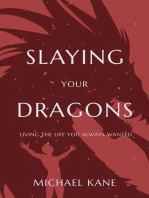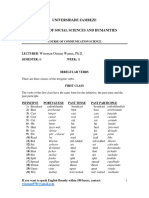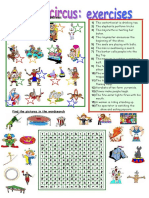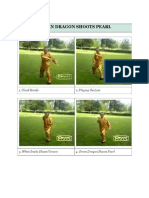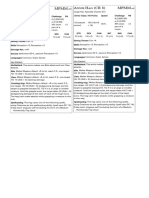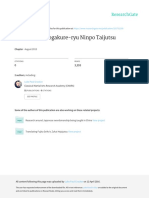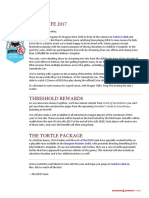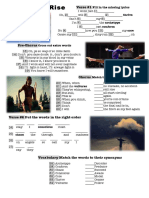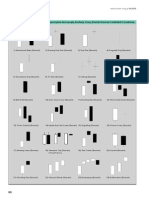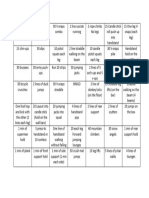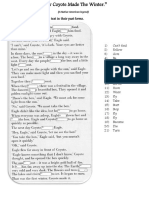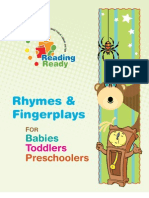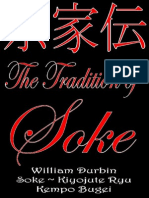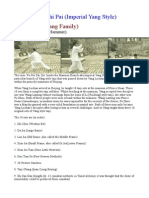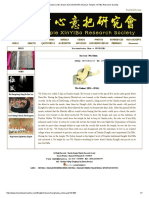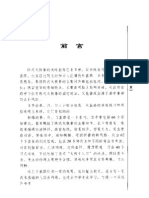Professional Documents
Culture Documents
The Thirty Seven Essential Forms of the Yang-style Taijiquan (108) 三十七式楊式太極拳
Uploaded by
puño_santoOriginal Title
Copyright
Available Formats
Share this document
Did you find this document useful?
Is this content inappropriate?
Report this DocumentCopyright:
Available Formats
The Thirty Seven Essential Forms of the Yang-style Taijiquan (108) 三十七式楊式太極拳
Uploaded by
puño_santoCopyright:
Available Formats
The Thirty Seven Essential Forms of the Yang-style Taijiquan (1081)
三十七式楊式太極拳(一百八) Translated and interpreted by Sam Masich (馬希奇)
The 37 Essential Forms 2 listed in the order they first appear in the traditional long form3 :
1) Ward-off péng 掤
2) Roll-back lǚ 扌履
3) Press jǐ 擠
4) Push àn 按
5) Single Whip dān biān 單鞭
6) Raise Hands, Step-up tí shǒu shàng shì 提手上式
7) White Crane Spreads its Wings bái hè liàng chì 白鶴亮翅
8) Brush Knee, Twist-step lǒu xī ǎo bù 摟膝拗步
9) Hand Plays the Guitar shǒu huī pí pá 手揮琵琶
10) Step-up, Deflect Downward, Parry & Punch jìn bù bān lán chuí 進步搬攔捶
11) Apparent Closure (& Counter with Push) rú fēng sì bì 如封似閉
12) Cross Hands shízì shǒu 十子手
13) Fist Under Elbow zhǒu dǐ chuí 肘底捶
14) Step Back, Repulse like Monkey dǎo niǎn hóu 倒攆猴
15) Diagonal Flying xié fēi shì 斜飛式
16) Needle at Sea Bottom hǎi dǐ zhēn 海底針
17) Fan Through the Back shàn tōng bèi 扇通背
18) Turn & Chop Opponent with Fist zhuǎn shēn piě shēn chuí 轉身撇身捶
19) Cloud Hands yún shǒu 雲手
20) High Pat on Horse gāo tàn mǎ 高探馬
21) Parting Kick fēn jiǎo 分腳
22) Kick with Sole dēng jiǎo 登腳
23) Step-up, Punch Down jìn bù zāi chuí 進步栽捶
24) Rising Kick tī jiǎo 踢腳
25) Hit Tiger dǎ hǔ 打虎
26) Double Winds Pierce Ears shuāng fēng guàn ěr 雙風貫耳
27) Part the Wild Horse’s Mane yě mǎ fēn zōng 野馬分鬃
28) Fair Maiden Weaves at Shuttles yù nǚ chuān suō 女穿梭
29) Snake Creeps Down shé shēn xià shì 蛇身下勢
30) Golden Rooster Stands on One Leg jīn jī dú lì 金雞獨立
31) White Snake Puts-out Tongue bái shé tǔ xìn 白蛇吐信
32) Palm Thrust shí zǐ zhǎng 十子掌
33) Step-up, Punch to Groin jìn bù zhǐ dāng chuí 進步指襠捶
34) Step-up, Form Seven Stars shàng bù qī xīng 上步七星
35) Retreat to Ride the Tiger tuì bù kuà hǔ 退步跨虎
36) Turn body, Sweep the Lotus zhuǎn shēn bǎi lián tuǐ 轉身擺蓮腿
37) Bend Bow, Shoot Tiger wān gōng shè hǔ 彎弓射虎
The Thirteen Families of the Thirty Seven Essential Forms
一三家 三十七式 楊式太極拳
1) Peng family: péng jiā 掤家
1) Ward-off péng
3) Press jǐ
27) Part the Wild Horse’s Mane yě mǎ fēn zōng
15) Diagonal Flying xié fēi shì
19) Cloud Hands yún shǒu
2) Lü family: lǚ jiā 扌履家
2) Roll-back lǚ
16) Needle at Sea Bottom hǎi dǐ zhēn
14) Step Back, Repulse like Monkey dǎo niǎn hóu
19) Cloud Hands yún shǒu
(Roll Back into Press Variations) lǚ, jǐ
3) An family: àn jiā 擠家
4) Push àn
3) Press jǐ
8) Brush Knee, Twist-step lǒu xī ǎo bù
28) Fair Maiden Weaves at Shuttles yù nǚ chuān suō
11) Apparent Closure (& Counter with Push) rú fēng sì bì
4) Single Whip family: dān biān jiā 單鞭家
5) Single Whip dān biān
17) Fan Through the Back shàn tōng bèi
29) Snake Creeps Down shé shēn xià shì
5) Raise Hands family: tí shǒu jiā 提手家
6) Raise Hands, Step-up tí shǒu shàng shì
9) Hand Plays the Guitar shǒu huī pí pá
13) Fist Under Elbow zhǒu dǐ chuí
6) White Crane family: bái hè jiā 白鶴家
7) White Crane Spreads Its Wings bái hè liàng chì
20) High Pat on Horse gāo tàn mǎ
35) Retreat to Ride the Tiger tuì bù kuà hǔ
7) Step-up, Hit family: jìn bù chuí jiā 進步捶家
10) Step-up, Deflect Downward, Parry & Punch jìn bù bān lán chuí
23) Step-up, Punch Down jìn bù zāi chuí
33) Step-up, Punch to Groin jìn bù zhǐ dāng chuí
8) Cross Hands family: shízì shǒu jiā 十字手家
11) Apparent Closure (& Counter with Push) rú fēng sì bì
12) Cross Hands (Embrace Tiger, Return to Mountain) shízì shǒu (bào hǔ guī shān)
34) Step-up, Form Seven Stars shàng bù qī xīng
9) Kick family: jiǎo jiā 腳家
21) Parting Kick fēn jiǎo
22) Kick with Sole dēng jiǎo
24) Rising Kick tī jiǎo
30) Golden Rooster Stands on One Leg jīn jī dú lì
36) Turn to Sweep the Lotus zhuǎn shēn bǎi lián tuǐ
10) Turn Body family: zhuǎn shēn jiā 轉身家
28) Fair Maiden Weaves at Shuttles yù nǚ chuān suō
12) Cross Hands (Embrace Tiger, Return to Mountain) shízì shǒu (bào hǔ guī shān)
18) Turn & Chop Opponent with Fist zhuǎn shēn piě chuí
36) Turn to Sweep the Lotus zhuǎn shēn bǎi lián tuǐ
11) Hit Tiger family: dǎ hǔ jiā 打虎家
25) Hit Tiger dǎ hǔ
26) Double Winds Pierce Ears shuāng fēng guàn ěr
37) Bend Bow, Shoot Tiger wān gōng shè hǔ
34) Step-up, Form Seven Stars shàng bù qī xīng
12) White Snake family: bái shé jiā 白蛇家
31) White Snake Puts Out Tongue bái shé tǔ xìn
30) Golden Rooster Stands on One Leg jīn jī dú lì
32) Palm Thrust shí zǐ zhǎng
16) Needle at Sea Bottom hǎi dǐ zhēn
13) Seven Stars family: qī xīng jiā 七星家
34) Step-up, Form Seven Stars shàng bù qī xīng
6) Raise Hands, Step-up (Hand Plays Guitar; Fist Under Elbow) tí shǒu shàng shì (shǒu huī pípá; zhǒu dǐ chuí)
7) White Crane Spreads Wings (High Pat Horse; Ride Tiger) bái hè liàng chì (gāo tàn mǎ; tuì bù kuà hǔ)
1 The Yang Style Taijiquan barehand routine is often described as comprising one hundred and eight move-
ment forms. This number—considered sacred in Buddhism—likely reflects the legacy of the formʼs partial
Buddhist Shaolin style martial art roots which predate Chen family origins. The 108 count however, is only one
of many ways of tallying the movements of this form. Reckoning depends on such factors as: individual
teachersʼ preferences for number of repetitions in grouped movements (i.e. ʻWave Hands Like Cloudsʼ, three
repetitions or five); whether or not such grouped movements are counted individually (i.e. ʻWave Hands Like
Cloudsʼ five times as a single count or as five counts); whether or not grouped movements are counted the
same way in subsequent repetitions (i.e. ʻCloud Handsʼ three times, as three counts the first time it appears
but as only a single count thereafter); etc. There are various counting permutations in the ʻCommencingʼ and
ʻClosingʼ parts of the form. Some enumerate ʻOpening Stanceʼ as well as ʻOpening Formʼ or ʻClosing Formʼ as
well as ʻReturn to Originʼ. Criteria for making tallying decisions are vague, therefore the count is subject to
interpretation. While there is not much consistency in this matter from school to school, neither is there much
discord as to which way is correct or ideal.
Here are some examples of the different counts (from lesser to greater) for the Yang-style Taijiquan long form
by various teachers and authors. While tabulations vary, each enumerates the exact same series of postures:
81—Tseng Ju-Pai; 82—Douglas Lee; 85—Yang Chengfu/Fu Zhongwen; 88—Li Tianji; 89—Wen-Shan
Huang—; 103—Yang Zhenduo; 105—Jou Tsung Hwa; 105—Lee Shu Pak; 108—Chen Yanlin; 108—Chung
Yun Man; 108—Dr. Yang Jwing Ming; 108—Moy Lin Shin; 124—Yang Shouzhong; 150—T.T. Liang.
In fact there are between thirty-five and forty individual forms in the Yang barehand form. But even in this mat-
ter there is some difference as to what qualifies for counting, as some schools recognize ʻOpeningʼ and ʻClos-
ingʼ as independent forms. Decisions as whether or not to list similar type movements such as; ʻKick with Soleʼ
and ʻRising Kickʼ; or, ʻTurn to Chop Opponent with Fistʼ and ʻWhite Snake Puts-out Tongueʼ; or, ʻPunch Downʼ
and ʻPunch to Groinʼ can also affect the basic tally. So can counting left and right-style variations (which could
bring the number up to between 50-55).
Older documents describe thirty-seven essential ʻformsʼ in the Yang family long-fist (chang quan 長拳) routine.
The most famous use of the number ʻ37ʼ as a counting device is in Zheng Manqingʼs (Chʼeng Man-ching)
popular 37 movement routine. Not all the actual essential postures are present in the Zheng sequence however,
and this may have been a factor in obfuscating the topic in recent generations.
2 shì 式 — literally ‘styles’, ‘forms’ or ‘patterns’. Often translated as ‘movements’ or ‘postures’
3 Yang Chengfu lists thirty-seven core forms in his 1931 book, ʻTaijiquan Method and Applicationʼ (Tàijíquán
Shǐyòngfǎ 太極拳使用法)—[not to be confused with his 1934 ʻEssence and Applications of Taijiquanʼ
(tǐyòngquánshū 太極拳體用全書)]—and suggests that these are essential to the understanding of martial
application. He indicates that a more exhaustive explanation would be forthcoming in a later volume. Yang
died in 1936 and no such book is known to have been written. Yangʼs thirty-seven itemize several forms in
both left and right side variations and lump ʻpengʼ, ʻluʼ, ʻjiʼ and ʻanʼ together under the banner of ʻGrasp Spar-
rowʼs Tailʼ. As well ʻRising Kickʼ; ʻWhite Snake Puts Out Tongueʼ; and ʻTurn to Sweep the Lotusʼ are omitted. In
this sense this is not quite a true list of the ʻessential formsʼ. Here is the list of Yang Chengfuʼs ʻThirty-seven
Forms of Taijiquan Individually Namedʼ (三十七式太極拳各式名稱):
1. Grasp Sparrow's Tail (lǎn què wěi 攬雀尾); 2. Single Whip (dān biān 單鞭); 3. Raise Hands (tí shǒu 提手);
4. White Crane Spreads its Wings (bái hè liàng chì 白鶴亮翅); 5. Brush Knee, Twist-step (left style) (lǒu xī ǎo
bù (zuǒ shì)
左摟膝拗步); 6. Brush Knee, Twist-step (right style) (lǒu xī ǎo bù (yòu shì) 右摟膝拗步); 7. ʻPipaʼ
(pípá 琵琶式); 8. Deflect Downward, Parry & Punch (bān lán chuí 搬攔捶); 9. Apparent Closure (rú fēng sì bì
如封似閉); 10. Cross Hands (shízì shǒu 十字手); 11. Embrace Hands, Return to Mountain (bào shǒu guī shān
抱手歸山); 12. Fist Under Elbow (zhǒu dǐ chuí 肘底捶); 13. Step Back, Repulse like Monkey
(dǎo niǎn
hóu 倒攆猴); 14. Diagonal Flying (xié fēi shì 斜飛); 15. Needle at Sea Bottom (hǎi dǐ zhēn 海底針); 16. Fan
Through the Back (shàn tōng bèi 扇通背); 17. Chop Opponent with Fist (zhuǎn shēn piě shēn chuí 撇身捶);
18. Cloud Hands (yún shǒu 雲手); 19. High Pat on Horse (gāo tàn mǎ 高探馬); 20. Parting Kick (fēn jiǎo 分腳);
21. Left Turn Body and Kick with Sole
(zuǒ zhuǎnshēn dēng jiǎo 左轉身蹬腳); 22. Step-up, Punch Down (jìn
bù zāi chuí 進步載捶); 23. Turn-over Body Kick with Sole (fān shēn dēng jiǎo 翻身蹬腳); 24. Right Turn Body
Kick with Sole (yòu zhuǎnshēn dēng jiǎo 右轉身蹬腳); 25. Double Winds Pierce Ears (shuāng fēng guàn ěr 雙
峰貫耳); 26. Left & Right Hit Tiger (zuǒ yòu dǎ hǔ 左右打虎); 27. Part the Wild Horseʼs Mane (yě mǎ fēn
zōng 野馬分鬃); 28. Left Fair Maiden Weaves at Shuttles (zuǒ yù nǚ chuān suō 左玉女穿梭)
29. Right Fair Maiden Weaves at Shuttles (yòu yù nǚ chuān suō 右玉女穿梭); 30. Single Golden Rooster
Stands on One Leg (jīn jī dú lì 單下金雞獨立); 31. Right Golden Rooster Stands on One Leg (yòu jīn jī dú lì
右邊金雞獨立); 32. Facing Palm (yíng miàn zhǎng 迎面掌); 33. Brush Knee, Punch Groin (lǒu xī zhǐ dāng chuí
摟膝指襠捶); 34. Step-up, Form Seven Stars (shàng bù qī xīng 上步七); 35. Retreat to Ride the Tiger (tuì bù
kuà hǔ 退步跨虎); 36. Turn Foot to Ride the Tiger (tuì jiǎo kuà hǔ 轉腳擺蓮); 37. Bend Bow, Shoot Tiger (wān
gōng shè hǔ 彎弓射虎)
You might also like
- Rapport sur les Travaux Gravimetriques Antarctique: Annals of The International Geophysical Year, Vol. 31From EverandRapport sur les Travaux Gravimetriques Antarctique: Annals of The International Geophysical Year, Vol. 31P. TardiNo ratings yet
- Yang Style 108 Long FormDocument1 pageYang Style 108 Long Formfalungongboy6587No ratings yet
- Denumiri Forme Laojia YiluDocument4 pagesDenumiri Forme Laojia Yiluuda2013No ratings yet
- Kumpulan Soal Tahaduts Kelas 1 SEMESTER GENAP 2021-2022 (Kumpulan Soal Pilihan Ganda) (1Document5 pagesKumpulan Soal Tahaduts Kelas 1 SEMESTER GENAP 2021-2022 (Kumpulan Soal Pilihan Ganda) (1rina alfrieNo ratings yet
- IrregularDocument6 pagesIrregularJeremiashNo ratings yet
- WORD SEARCH (Chocolates Names) There Are 30 Tithis in Each Lunar Month: Krishna Paksha (Dark Fortnight) Shukla Paksha (Bright Fortnight)Document1 pageWORD SEARCH (Chocolates Names) There Are 30 Tithis in Each Lunar Month: Krishna Paksha (Dark Fortnight) Shukla Paksha (Bright Fortnight)Sravan ReddyNo ratings yet
- Trajectory DataDocument70 pagesTrajectory DataJohn SalazarNo ratings yet
- Yang Sword Form. - Yang Taijiquan Style Sword (Jian) Form (53 Forms)Document7 pagesYang Sword Form. - Yang Taijiquan Style Sword (Jian) Form (53 Forms)Sergei JvjvjgNo ratings yet
- Tekken Tag TournamentDocument78 pagesTekken Tag TournamentCARLOS ALBERTO MILLAN CURINo ratings yet
- Circus Exercises Fun Activities Games 25810Document3 pagesCircus Exercises Fun Activities Games 25810Arturo Fuentes BravoNo ratings yet
- Denumiri Posturi Laojia ErluDocument3 pagesDenumiri Posturi Laojia Erluuda2013No ratings yet
- 10 Small Mantras 090909 PDFDocument10 pages10 Small Mantras 090909 PDFDan MerNo ratings yet
- Chen Tai Chi 83 Form NamesDocument4 pagesChen Tai Chi 83 Form NamesFlorin TronaruNo ratings yet
- Chen Xiaojia YiluyingDocument3 pagesChen Xiaojia YiluyingPaco MarínNo ratings yet
- Yang Style T'Ai Chi Ch'Uan Traditional 108-Movement Long FormDocument2 pagesYang Style T'Ai Chi Ch'Uan Traditional 108-Movement Long FormKrupal VithlaniNo ratings yet
- Green Dragon Shoots PearlDocument9 pagesGreen Dragon Shoots Pearlphu nongNo ratings yet
- Com 3° Práctica Accidentes Sustantivo Ii PDFDocument3 pagesCom 3° Práctica Accidentes Sustantivo Ii PDF我•Ʀoγεг MSNo ratings yet
- Tai Chi 108 Form PDFDocument5 pagesTai Chi 108 Form PDFRohanNo ratings yet
- Carry Tiger Back To MountainDocument11 pagesCarry Tiger Back To Mountainphu nongNo ratings yet
- Bagua Zhuan Huan ZhangDocument6 pagesBagua Zhuan Huan Zhangjilongfeng666No ratings yet
- Yang-Style 103-Form List of Postures: Chinese Pinyin English Section 1Document4 pagesYang-Style 103-Form List of Postures: Chinese Pinyin English Section 1Gary LoweNo ratings yet
- Simple Past - Irregular VerbsDocument1 pageSimple Past - Irregular VerbsclaugarrodNo ratings yet
- Simple Past - Irregular VerbsDocument1 pageSimple Past - Irregular VerbsClaudia GarcésNo ratings yet
- 21 Savage, Offset & Metro Boomin - Ghostface Killers LyricsDocument3 pages21 Savage, Offset & Metro Boomin - Ghostface Killers LyricsRaze CrageNo ratings yet
- Masich Sam. - Way of The Tai Chi Sword - Yang Style TaijijianDocument4 pagesMasich Sam. - Way of The Tai Chi Sword - Yang Style TaijijianSergei JvjvjgNo ratings yet
- A H MPMM A H (CR 8) MPMMDocument5 pagesA H MPMM A H (CR 8) MPMMgino chicloteNo ratings yet
- Togakure-Ryu Ninjutsu (Luke's Translation)Document12 pagesTogakure-Ryu Ninjutsu (Luke's Translation)jlfloridodNo ratings yet
- YangDocument1 pageYangJohanna LennonNo ratings yet
- Verbos Regulares PDFDocument15 pagesVerbos Regulares PDFEriksen Mallma MoránNo ratings yet
- Yang Cheng Fu - Tai Chi Form-108Document1 pageYang Cheng Fu - Tai Chi Form-108kahuna_ronbo3313No ratings yet
- The Chaos' The Chaos' The Chaos': by Gerard Nolst Treni by Gerard Nolst Trenité by Gerard Nolst TrenitéDocument5 pagesThe Chaos' The Chaos' The Chaos': by Gerard Nolst Treni by Gerard Nolst Trenité by Gerard Nolst TrenitéAlistair BrownNo ratings yet
- ChineseJumpRopeActivities 1Document5 pagesChineseJumpRopeActivities 1Lukács Norbert CsabaNo ratings yet
- Soalan Bahagian A Slps PPT - SkemaDocument18 pagesSoalan Bahagian A Slps PPT - Skemaalbayt centreNo ratings yet
- Finger Play CardsDocument6 pagesFinger Play Cardsapi-455938962No ratings yet
- Takagi Yoshin Ryu MokurokuDocument5 pagesTakagi Yoshin Ryu MokurokuBzchut HaBaba SaliNo ratings yet
- The Fourty Form.Document1 pageThe Fourty Form.TaiChiShadowBoxingNo ratings yet
- Extra Life 2017: Twitch - TV/DNDDocument2 pagesExtra Life 2017: Twitch - TV/DNDDan DesiletsNo ratings yet
- Muay Thai TechniquesDocument33 pagesMuay Thai TechniquesSalahudin Al AhyudinNo ratings yet
- Presentation On TitleDocument62 pagesPresentation On TitleKartikNo ratings yet
- Verse #1: Fill in The Missing Lyrics Thrive Archetype Conform CoreDocument1 pageVerse #1: Fill in The Missing Lyrics Thrive Archetype Conform CoreIonela Loredana BatogNo ratings yet
- ACTIVITY Hey Soul Sister by TrainDocument1 pageACTIVITY Hey Soul Sister by TrainAnnie MartinezNo ratings yet
- Daily Com: Free CrosswordsDocument1 pageDaily Com: Free CrosswordsCosmin CernatNo ratings yet
- Andap, Lloyd Sinawli1Document10 pagesAndap, Lloyd Sinawli1Skylar Jansen Clay AndapNo ratings yet
- Señales ArbitralesDocument3 pagesSeñales ArbitralesLuciano PaoliniNo ratings yet
- Togakure ryuNinjutsuLukesTranslationDocument12 pagesTogakure ryuNinjutsuLukesTranslationJohan EstivenNo ratings yet
- BINGO - HalloweenDocument1 pageBINGO - HalloweenpattyfiruNo ratings yet
- ςυνοπτική Παρουσίαση ςχηματισμών κηροπηγίων αντιστροφής ανοδικής Τάσης (Bearish Reversal Candlestick Formations)Document1 pageςυνοπτική Παρουσίαση ςχηματισμών κηροπηγίων αντιστροφής ανοδικής Τάσης (Bearish Reversal Candlestick Formations)constantineNo ratings yet
- Togakure ryuNinjutsuLukesTranslationDocument12 pagesTogakure ryuNinjutsuLukesTranslationsojoboninjaNo ratings yet
- 7Document2 pages7qk7d8nzpy7No ratings yet
- Kcpewarmup Class8Cretopi Calquesti Ons: Formar Ki Ngschemescal Lmrmachuki 0795491185Document7 pagesKcpewarmup Class8Cretopi Calquesti Ons: Formar Ki Ngschemescal Lmrmachuki 0795491185Godwin AyiekoNo ratings yet
- RoperDocument1 pageRopergino chicloteNo ratings yet
- Bingo 2Document1 pageBingo 2pattyfiruNo ratings yet
- Guia de 50 Canciones 19-20Document55 pagesGuia de 50 Canciones 19-20Amanda SequeraNo ratings yet
- How Coyote Made The WinterDocument2 pagesHow Coyote Made The WinterAndreia SimõesNo ratings yet
- Taiji Two Person Se (Taiji Sanshou Duida)Document63 pagesTaiji Two Person Se (Taiji Sanshou Duida)evernever100% (2)
- Tekken Tag Tournament KINGDocument4 pagesTekken Tag Tournament KINGCARLOS ALBERTO MILLAN CURINo ratings yet
- Web Nursery RhymesDocument23 pagesWeb Nursery RhymesCar Rio BNo ratings yet
- Start A New Game Make Scene Make Crossroad: Reference SheetDocument1 pageStart A New Game Make Scene Make Crossroad: Reference SheetJustinNo ratings yet
- Boqonnaa ShanDocument44 pagesBoqonnaa Shanyusuf89% (9)
- KENPO 5.0: 1. Blocks and ParrysDocument3 pagesKENPO 5.0: 1. Blocks and Parryspuño_santoNo ratings yet
- StationsDocument2 pagesStationspuño_santoNo ratings yet
- Elvis Presley, Reluctant Rebel His Life and Our TimesDocument246 pagesElvis Presley, Reluctant Rebel His Life and Our Timespuño_santoNo ratings yet
- KENPO 5.0: 1. Blocks and ParrysDocument3 pagesKENPO 5.0: 1. Blocks and Parryspuño_santoNo ratings yet
- Taijiquan 13 Powers v1 PDFDocument2 pagesTaijiquan 13 Powers v1 PDFconcretemanmcNo ratings yet
- Neijia Terms W Chinese PDFDocument7 pagesNeijia Terms W Chinese PDFLibarnesNo ratings yet
- Long Weapon Basics - JP LauDocument54 pagesLong Weapon Basics - JP Laukahuna_ronbo3313100% (1)
- The Tradition of SokeDocument62 pagesThe Tradition of Sokepsychicpenguin100% (1)
- Black Tiger KungfuDocument110 pagesBlack Tiger KungfuAzuca100% (1)
- Wandering Heroes of Ogre Gate PDFDocument492 pagesWandering Heroes of Ogre Gate PDFpacalypse100% (9)
- J. J. Estrella Sanchez - Zhang San Feng. One Man One Destiny (Thesis)Document21 pagesJ. J. Estrella Sanchez - Zhang San Feng. One Man One Destiny (Thesis)nqngestion100% (2)
- SLTE Infopaket 2023 (EN)Document22 pagesSLTE Infopaket 2023 (EN)PunalesNo ratings yet
- CLF PageDocument3 pagesCLF Pageblacklotus39No ratings yet
- Interview Shi MingDocument10 pagesInterview Shi MingTibzNo ratings yet
- Chuan Na Quan Product 300039802Document111 pagesChuan Na Quan Product 300039802some dude100% (2)
- Imperial Yang Style PDFDocument8 pagesImperial Yang Style PDFrikymediaNo ratings yet
- Warrior ContentsDocument8 pagesWarrior ContentsnussbaumerNo ratings yet
- 6 MUnpDocument1 page6 MUnpRondel BenjaminNo ratings yet
- Kung Fu Long ArmsDocument10 pagesKung Fu Long Armscrazedjustice888No ratings yet
- Successor - Wu Gulun-SUCCESSORS-ShaoLin Temple XinYiBa Research SocietyDocument1 pageSuccessor - Wu Gulun-SUCCESSORS-ShaoLin Temple XinYiBa Research SocietyBhuvnesh Tenguria100% (1)
- Glossary of Terms in Wuxia, Xianxia & Xuanhuan Novels - Immortal MountainDocument15 pagesGlossary of Terms in Wuxia, Xianxia & Xuanhuan Novels - Immortal MountainSean BrownNo ratings yet
- Wing Chun PDFDocument8 pagesWing Chun PDFLuiz Augusto100% (1)
- List of Chinese Martial ArtsDocument4 pagesList of Chinese Martial ArtsDimGoanNo ratings yet
- 1anderson Dan American Freestyle Karate A Guide To Sparring 4Document326 pages1anderson Dan American Freestyle Karate A Guide To Sparring 4Сергей Фомин100% (4)
- Wu Jaingquan's Tai ChiDocument111 pagesWu Jaingquan's Tai ChiRonaldo Briant100% (3)
- Fine Chen of Taijiquan Quanjian Knife (Wu Shijun)Document322 pagesFine Chen of Taijiquan Quanjian Knife (Wu Shijun)Danut Tir100% (3)
- Wushu:: A Culture of AdversariesDocument19 pagesWushu:: A Culture of AdversariesIyappan SubramaniNo ratings yet
- Chen Xiaowang, Jan Silberstorff - Five Levels of TAIJIQUAN - PDF (OCR) PDFDocument94 pagesChen Xiaowang, Jan Silberstorff - Five Levels of TAIJIQUAN - PDF (OCR) PDFaryaa2020No ratings yet
- Bryandale News Vol 015 - 2006 08 31Document2 pagesBryandale News Vol 015 - 2006 08 31api-3718598100% (2)
- Jou Tsung Hwa - Taijiquan HistoryDocument3 pagesJou Tsung Hwa - Taijiquan HistorynqngestionNo ratings yet
- Kung Fu DissertationDocument81 pagesKung Fu DissertationabstractiusNo ratings yet
- Christianity and The Martial ArtsDocument33 pagesChristianity and The Martial Artsbookworm441No ratings yet
- Dragon DoorDocument7 pagesDragon DoorMihaela AvaNo ratings yet
- Historical Development of Physical EducationDocument17 pagesHistorical Development of Physical EducationJeremy NableNo ratings yet
- Brief History of Our Kalari TraditionDocument15 pagesBrief History of Our Kalari TraditionAdhithya KiranNo ratings yet
- Wing Chun S First Form - Siu Lim TaoDocument2 pagesWing Chun S First Form - Siu Lim TaoGregory RodriguezNo ratings yet
